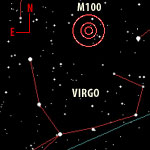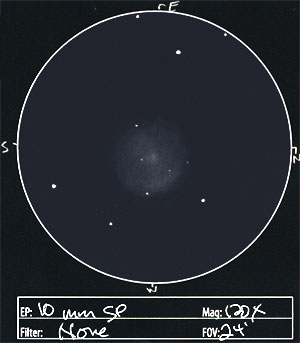Move mouse over image for labels.
Observation Notes:
 My search for Supernova 2006X, was a good opportunity to observe M100 as well. The galaxy was circular with a bold, condensed core. There was a hint of mottling in its outer stretches. The brightest portion appeared to extend northwest to southeast, with a brighter patch arcing around the northwest side.
My search for Supernova 2006X, was a good opportunity to observe M100 as well. The galaxy was circular with a bold, condensed core. There was a hint of mottling in its outer stretches. The brightest portion appeared to extend northwest to southeast, with a brighter patch arcing around the northwest side.
Trying to spot SN2006X was difficult, as I figured it would be (if I could see it at all). The stars marked A and B in the rollover graphic were faint (listed as mag. 14.2 by the AAVSO), but constantly seen. An extremely faint stellar object flickered occasionally at a point midway between A and B. During a 3-4 second of preciously agreeable seeing, that stellar point flickered more obviously, and gave me more confidence in the sighting.
Factoids:
One of the brightest Virgo Cluster galaxies, M100 is a spiral that faces us nearly face on. It has 2 main bright spiral arms and several fainter arms. Star formation has been sparked in spiral arms due to interactions with neighboring galaxies. It lies about 56 million light years away. M100 was discovered in 1781 by Pierre Méchain and subsequently catalogued by Charles Messier.
SN2006X is a type Ia supernova that was discovered February 7, 2006 at mag. 15.3 by Shoji Suzuki and M. Migliardi. By February 18th, it had reached a brightness of 13.5.
| Subject | M100 (NGC 4321) |
| Classification* | Spiral Galaxy (Type Sc) |
| Position* | Coma Berenices [RA: 12:22:54.9 / Dec: +15:49:21] |
| Size* | 7.4′ x 6.3′ |
| Brightness* | 9.3 vMag/10.1 bMag/13.3 Surface Brightness |
| Date/Time | February 25, 2006 – 02:00 AM MST (February 25, 2006 – 09:00 UT) |
| Observing Loc. | Anderson Mesa, AZ |
| Instrument | Orion SVP 6LT Reflector (150 mm dia./1200 mm F/L) |
| Eyepieces/Mag. | 10 mm (120X) |
| Conditions | Clear, calm, 20°F |
| Seeing | 3-4/10 |
| Transparency | Mag 6.8 |
| *Sources | Orion’s The Sky Software NGC/IC Project SEDS |
